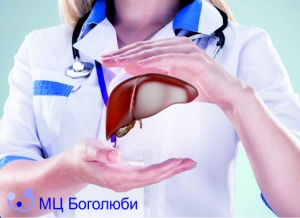Hepatic cysts are small pockets or cavities filled with fluid or other organic material localized within the body. In most cases, these formations are not a serious cause for concern, since they rarely affect the functional abilities of the liver. However, there are also pathological cysts, the appearance of which serves as a signal of more or less serious diseases.
Classification of hepatic
cysts Liver cysts can be single, multiple, simple (rounded, well defined) or complex (not round, clearly not limited).
Simple hepatic cysts – are the most common. These are benign formations, filled with liquid, not causing any clinical manifestations. The reasons that lead to their appearance are unknown, but many scientists believe that they are the result of congenital abnormalities that arose during the intrauterine development of the bile ducts.
Simple cysts are not dangerous, and therefore, there is no need to remove them. If they are characterized by a significant amount, it is recommended to periodically monitor them to check if they are growing. If these cysts are disturbing, it is advisable to evaluate their possible removal (fluid aspiration, resection, etc.) Hydatide cysts are caused by the development of granular echinococcus in the liver. The disease may remain asymptomatic for a long period of time. These cysts, as a rule, are detected by chance, with ultrasound or X-ray. In some cases, it is these cysts that cause itching, hives, and pain in the right hypochondrium. If the cyst is very bulky or develops in front, then on palpation it is defined as round bloating.
Polycystic liver disease is characterized by the presence of numerous cystic formations. In 50% of patients with this diagnosis, cystic kidney damage is also observed. The disease can cause functional disorders of the liver. Caroli's disease is a rare congenital pathology, accompanied by the presence of multiple cysts in the intrahepatic bile ducts.
Caroli's disease – is a rare congenital pathology, accompanied by the presence of multiple cysts in the intrahepatic bile ducts. The disease carries a high risk of cholangiocarcinoma.
The diagnosis of hepatic cysts is confirmed by ultrasound and immunological studies. If there is a suspicion of parasitic cystic formation, then it is necessary to conduct serological blood tests.
The growth of cysts often leads to such manifestations as belching, nausea, baseless feeling of satiety, diarrhea, aggravated by physical exertion, pain in the right side. The patient is also disturbed by weakness, shortness of breath, decreased appetite and excessive sweating. The inflammatory process of the cyst is characterized by fever, chills, and increased pain.
What to do?
If the patient is faced with a small non-parasitic cyst, then in this case it is enough to be regularly observed by a gastroenterologist and follow a healthy diet that excludes fried, fatty, salty and smoked from the menu.
Fresh vegetables and fruits, dairy products should be preferred. Drug treatment of a cyst makes sense in case of its parasitic origin. Anthelmintics, analgesics, antiemetic drugs, hepatoprotectors and immunomodulators are prescribed. To eliminate the phenomena of intestinal dyspepsia, probiotics and enzyme preparations are used.
Surgical intervention is indicated in the case of the following complications:
- cyst rupture;
- suppuration;
- bleeding;
- obstructive jaundice;
- large cysts (over 5 - 10 cm) with severe symptoms (severe pain, significant weight loss).
В In Bogolyuby MC, hepatic cysts are removed by laparoscopic surgery, which is the least traumatic and provides the patient with not only a short recovery period, but also a cosmetic effect. Only a specialist can help you choose the best method to get rid of the problem.
















